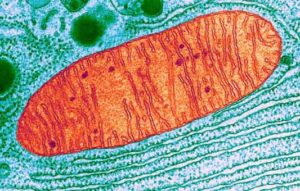
Photomicrograph of a mitochondrion. Credit: University of Wisconsin-Madison College of Agricultural and Life Sciences
With Parkinson’s disease (as with Alzheimer’s) the processes of disposal of neuronal metabolism residues weaken, creating a dangerous accumulation.
As already highlighted by other works, cells eliminate “garbage” (metabolic waste) with autophagy, a normal and necessary process in which aggregates of proteins and damaged structures are processed.
But over the years the ability to eliminate waste decreases.
Even in the development of Parkinson’s disease, as in Alzheimer’s disease, problems with the mitochondria (the cell’s powerhouse) are a crucial aspect.
Scientists have long known that malfunctioning mitochondria are found in dopaminergic neurons.
Dopaminergic neurons, as well as other cells, control the quality of mitochondria that deteriorate and produce new ones.
These neurons already associated with reward and motivation processing are also associated with movement management.
Tremors, muscle stiffness and other movement problems are common among Parkinson’s patients.
Researchers at Johns Hopkins Medicine are taking a closer look at the molecular machinery that recycles mitochondria, the cell’s powerhouse, in efforts to ramp up the production of the energy-producing structures. Problems with mitochondria are a key aspect in the development of Parkinson’s disease.
In a study posted online Aug. 13, 2020, in the journal Stem Cell Reports, the researchers focused on brain cells called neurons which release a chemical messenger called dopamine.
To study neurons associated with the disorder, scientific tools have recently been developed.
These include fluorescent probes that can be easily used to identify newly developed and older mitochondria, says Ted Dawson, M.D., Ph.D., professor of neurology and director of the Institute for Cell Engineering at the Johns Hopkins University School of Medicine.
In addition, a gene called PARKIN has been associated with a type of hereditary Parkinson’s disease that begins to appear in people younger than 40.
To better understand the gene’s behavior, Dawson’s team analyzed human dopamine neurons that lacked the PARKIN gene and were derived from both embryonic stem cells and people with Parkinson’s disease.
These neurons lost their ability to make new, fully functional mitochondria.
The scientists noticed that the PARKIN-lacking neurons with malfunctioning mitochondria had more activation of a protein-making gene called PARIS which is linked to mitochondria regulation.
When Dawson and his colleagues genetically engineered the neurons to remove the PARIS and PARKIN genes — and thus their protein products — the neurons were still able to manufacture new mitochondria and continue — although to a lesser extent — to remove old mitochondria.
Cells with more PARIS activation lose the ability to make new mitochondria and neurons with less PARIS seem to make mitochondria easily, with some — but not total — effect on old mitochondrial removal.
Dawson says this seems to indicate that the production of new mitochondria is critical to the maintenance and survival of dopamine neurons.
“Targeting PARIS with drugs to lower its protein levels may provide a new way to treat Parkinson’s disease,” says Dawson.
The value of patents owned by Valted LLC could be affected by the study described in this news item. Dawson is a founder of Valted LLC and holds an ownership equity interest in the company. This arrangement has been reviewed and approved by The Johns Hopkins University in accordance with its conflict of interest policies.
See also:
Speeding up waste disposal in the brain may slow down neurodegenerative diseases (2016-01-08)
Link…
The cleaning system of the brain cells tied to Alzheimer’s (2019-02-26)
Link…
Taking out the protein garbage becomes more difficult as neurons age (2019-08-06)
Link…
Researchers Find Textbook-Altering Link Between Brain, Immune System (2015-06-10)
Link…
That’s why sleeping well is very important (2020-03-11)
Link…
Parkinson’s Protein May Regulate Fat Metabolism (20/01/2012)
Link…
Scoperta la causa del Parkinson giovanile (24/10/2014)
Link…
Lymphatic vasculature: A cholesterol removal system (2013-04-12)
Link…
For more information
STEM CELL REPORTS
Defects in Mitochondrial Biogenesis Drive Mitochondrial Alterations in PARKIN-Deficient Human Dopamine Neurons
Link…
The Johns Hopkins Medicine
Link…
MDN
This post is also available in:
 Italian
Italian


